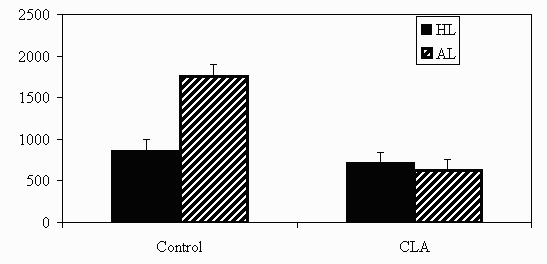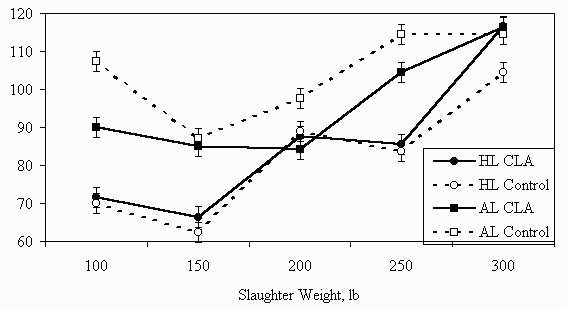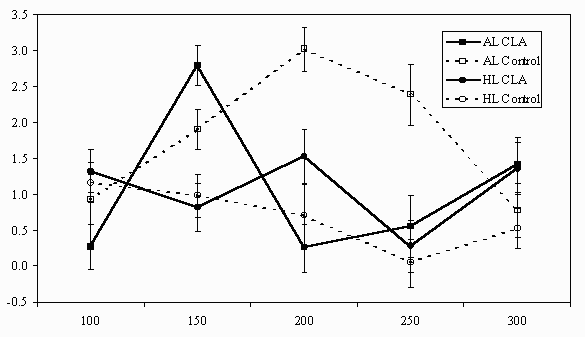
M.L. Heckart, J.M. Eggert, A.P. Schinckel, S.E. Mills, and
S.S. Donkin
Department of Animal Sciences
Conjugated linoleic acid (CLA) is a mixture of isomers of linoleic acid that act to reduce body fat in laboratory species (West et al., 1998; Park et al., 1999; Chin et al, 1994; Yamasaki et al., 1999) and pigs (Ostrowska et al., 1999; Muller et al., 1999). These fatty acids are commonly found in ruminant meat and milk (Lin et al., 1995) as a result of a biochemical modification of linoleic acid in the rumen, followed by absorption and incorporation of these fatty acids into animal products (Kepler et al., 1966). Alternatively, plant oils can be processed to increase their CLA content, which may prove to be a valuable source of CLA for use in modifying lipid metabolism in livestock and humans.
Despite animal trials indicating an effect of CLA in altering lipid content, the mechanism of CLA action has not been fully described. Adipose tissue harvested from pigs at slaughter can be processed into thin slices and kept alive in the laboratory for a limited period of time, and can be used as a tool to determine the mechanism of CLA action. Use of these adipose tissue explant cultures may provide information leading to a better understanding of changes in accumulation of carcass lipid in the growing pig with CLA feeding.
Feeding CLA appears to partially alleviate the undesirable processing characteristics of carcasses from genetic lines of pigs with greater propensity for lean gain. Specifically, including CLA in the finishing diet results in an increase in firmness of carcass fat, particularly pork bellies, from pigs with high rates of lean growth. Changes in the degree of adiposity and attributes of fat deposited with CLA feeding may be associated with changes in expression of key genes for lipid metabolism. Specifically, decreased expression of sterol CoA desaturase (SCD) may increase the saturated fatty acid levels in adipose tissue of pigs, leading to increased firmness of fat associated with bacon.
The objectives of the study presented here were: to determine the changes in adipose tissue metabolism that result from feeding pigs CLA, to determine these effects for two genotypes of pigs that differ in potential for lean growth, and to determine changes in expression of the SCD gene in adipose tissue with CLA feeding.
Materials and Methods
Sixty early-weaned gilts obtained from commercial sources were segregated and housed at the Purdue University Animal Sciences Research and Education Center Swine Unit. When pigs reached an average weight of 50 lb, two crosses consisting of 30 gilts each were assigned to either a .6% CLA or 1% sunflower oil diet (Table 1). The CLA was obtained from ConLinCo, Inc. (Detroit Lakes, MN). The average lean line (AL) was a Neu-Dalland terminal sire x PIC Camborough 22 dam cross with expected 52% fat free lean. The high lean line (HL) was a Large White terminal sire x (Large White x Landrace) dam with expected 54% fat free lean. Pigs from each treatment were slaughtered at 100, 150, 200, 250 and 300 lb.
After exsanguination, adipose tissue covering the 10th rib was removed and transported to the laboratory. Tissue was sliced to 300 m m thickness, and subdivided into explants weighing approximately 45 mg. Tissue was rinsed in culture media and placed into vials containing 3 mL of Krebs Ringer bicarbonate media containing 5.0 mmol/L U-[C14]glucose. The rate of incorporation of radioactive glucose was used to determine the effect of CLA on lipid synthesis. A sample of tissue was preserved with osmium tetraoxide for cell size analysis to determine the average cell areas for each adipose tissue preparation. Rates of lipid metabolism expressed as nmol of glucose incorporated into total lipid · 2h-1 · 106 cells-1. Expression of the SCD gene was examined by Northern blot analysis of total RNA from adipose tissue collected from all pigs at slaughter.
Results and Discussion
Lipogenesis in adipose tissue from HL pigs was 34% less than corresponding values for AL pigs (Figure 1). Feeding CLA decreased the rate of lipogenesis in the AL line by 64 ± 8% (P<.05) but did not appreciably alter lipogenesis in the HL line. Insulin is one of the primary regulators of lipid synthesis; therefore, we examined the effects of CLA on insulin action. Feeding CLA decreased (P<.05) the rate of lipogenesis in the presence of insulin for AL pigs but had little effect on insulin action in the HL pigs, perhaps because rates of lipid synthesis were already low. Rates of lipogenesis were greater in early growth phase, and the results indicate that CLA is most effective in reducing lipogenesis through 100 lbs of body weight. Furthermore, CLA appears most effective for the AL pigs (P<.05; genotype x diet x slaughter weight), perhaps because rates of fat synthesis are greatest in tissue from these animals.
The AL pigs had larger adipocytes compared to the HL pigs, and there was a tendency (P=.09) for decreased cell size in pigs consuming the diet containing CLA (Figure 2). Adipocyte size increased with increasing slaughter weight and was also responsive to genotype and diet (P<.05; genotype x diet x slaughter weight). Feeding CLA to the AL line decreased (P<.05) cell size an average of 8 ± 1%, and the greatest response to CLA (P<.05; slaughter weight x diet) was observed at 100 lb where adipocytes from AL pigs fed CLA were 16 ± 2% smaller than controls.
Expression of the SCD gene was lower for AL pigs compared with the HL pigs, which may reflect firmer fat for the AL compared to HL pigs at the same level of carcass lipid. The timing of response to CLA feeding on expression of SCD differed for AL and HL pigs. Feeding CLA to AL pigs decreased (P<.05) or tended to decrease (P=.13) SCD expression at 100 through 250 lb bodyweight. Feeding CLA tended (P=.15) to increase SCD expression in HL pigs at the 200 and 300 lb slaughter weights (Figure 3). These combined results indicate a beneficial effect of CLA on adipose tissue firmness and that these effects may be related to the timing of adipose tissue accretion characteristic of these genetic lines.
The present study demonstrates that feeding CLA to growing pigs decreases adipocyte cell size and the rate of lipogenesis in adipose tissue. Feeding CLA to growing pigs may effectively decrease body fat when pigs are not genetically predisposed to lower adipose accretion and therefore are limited in their responsiveness to agents that depress adipose accretion. On the other hand, feeding CLA may be beneficial in increasing desirable carcass characteristics related to adipose tissue composition. Part of the effects of CLA, despite little or no effect on gross lipogenesis, may be due to modification of the nature of fatty acids deposited as adipose tissue through changes in expression of genes for lipid metabolism. Although there was a minimal effect of CLA to reduce lipid synthesis in the HL pigs, the data indicate potential benefits to pork quality despite an already low carcass lipid content.
References
Chin, S.F., J.M. Storkson, K.J. Albright, M.E. Cook, and M.W. Pariza. 1994. Conjugated linoleic acid is a growth factor for rats as shown by enhanced weight gain and improved feed efficiency. J. Nutr. 124:2344-2349.
Kepler, C.R., K.P. Hirons, J.J. McNeill, and S.B. Tove. 1966. Intermediates and products of biohydrogenation of linoleic acid by Butyrivibrio fibrisolvens. J. Biol. Chem. 241:1350-1354.
Lin, H., T.D. Boylston, M.J. Chang, L.O. Luedecke, and T.D. Shultz. 1995. Survey of the conjugated linoleic acid contents of dairy products. J. Dairy Sci. 78:2358-2365.
Muller, H.L., G.I. Stangl, and M. Kirchgessner. 1999. Energy balance of conjugated linoleic acid-treated pigs. J. Anim. Physiol. Anim. Nutr. 81:150-156.
NRC. 1998. Nutrient Requirements of Swine (10th ed.). National Academy Press, Washington, DC.
Ostrowska, E., M. Muralitharan, R.F. Cross, D.E. Bauman, and F.R. Dunshea. 1999. Dietary conjugated linoleic acids increase lean tissue and decrease fat deposition in growing pigs. J. Nutr. 129:2037-2042.
Park, Y., K.J. Albright, W. Liu, J.M. Storkson, M.E. Cook, and M. Pariza. 1997. Effect of Conjugated Linoleic Acid on Body Composition in Mice. Lipids. 32:853-858.
West, D.B., J.P. DeLany, P.M. Camet, F. Blohm, A.A. Truett, and J. Scimeca. 1998. Effects of conjugated linoleic acid on body fat and energy metabolism in the mouse. Am. J. Physiol. 44:R667-R672.
Yamasaki, M., K. Mansho, H. Mishima, M. Kasai, M. Sugano, H. Tachibana, and K. Yamada. 1999. Dietary effect of conjugated linoleic acid on lipid levels in white adipose tissue of Sprague-Dawley rats. Bioschi. Biotechnol. Biochem. 63:1104-1106.
Table 1. As fed diet formulation of finisher stage diets, control and CLA treatments.
|
Ingredient, |
Finisher 1, |
Finisher 2, |
|
Added Oil, CLAa or controlb |
1.0 |
1.0 |
|
Corn |
78.3 |
83.2 |
|
Soybean Meal, 48% protein |
17.75 |
13.1 |
|
Dicalcium Phosphate |
1.46 |
1.25 |
|
Limestone |
.75 |
.80 |
|
Salt |
.30 |
.25 |
|
Lysine-HCl |
.15 |
.15 |
|
Vitamin Premixc |
.125 |
.10 |
|
Trace Mineral Premixd |
.075 |
.05 |
|
Selenium Premixe |
.04 |
.025 |
|
Tylan (18 g/kg) |
.05 |
.05 |
|
Chemical Composition1 |
|
|
|
Crude Protein |
15.1 |
13.6 |
|
ME, mcal/kgf |
3.28 |
3.37 |
|
Lysine |
.86 |
.73 |
|
Threonine |
.60 |
.54 |
|
Tryptophan |
.17 |
.135 |
|
Total Sulfur Amino Acids |
.55 |
.50 |
|
Calcium |
.70 |
.63 |
|
Phosphorus |
.60 |
.55 |
1
Percent as fed basis unless otherwise specified.

Figure 1. Effect of dietary CLA on glucose incorporation into total lipids for adipose tissue explants from average lean (AL) and high lean (HL) pigs. Values are least square means ± SEM (n=45). Feeding CLA has an effect on the AL line to decrease (P<.05) lipogenesis but had no effect on the HL line.

Figure 2. Effect of feeding CLA on average cell size in two genotypes of pigs at different slaughter weights. Data are least square means ± SEM (n=3). There were significant (P<.05) main effects of genotype and slaughter weight on adipocyte size, and a trend (P=.09) for an effect of CLA on adipocyte size.

Figure 3. Adipose tissue SCD expression in two genotypes of pigs fed either a CLA or a control diet. Values are least square means ± SEM (n=7, except AL CLA 250 lb: n=6 and AL control 250 lb: n= 5).